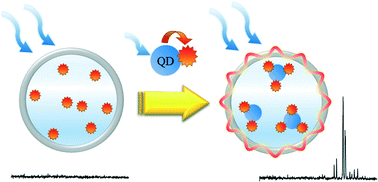Optofluidic FRET lasers using aqueous quantum dots as donors†
Abstract
An optofluidic FRET (fluorescence resonance energy transfer) laser is formed by putting FRET pairs inside a microcavity acting as a gain medium. This integration of an optofluidic laser and the FRET mechanism provides novel research frontiers, including sensitive biochemical analysis and novel photonic devices, such as on-chip coherent light sources and bio-tunable lasers. Here, we investigated an optofluidic FRET laser using quantum dots (QDs) as FRET donors. We achieved lasing from Cy5 as the acceptor in a QD–Cy5 pair upon excitation at 450 nm, where Cy5 has negligible absorption by itself. The threshold was approximately 14 μJ mm−2. The demonstrated capability of QDs as donors in the FRET laser greatly improves the versatility of optofluidic laser operation due to the broad and large absorption cross section of the QDs in the blue and UV spectral regions. The excitation efficiency of the acceptor molecules through a FRET channel was also analyzed, showing that the energy transfer rate and the non-radiative Auger recombination rate of QDs play a significant role in FRET laser performance.

- This article is part of the themed collection: Optofluidics

 Please wait while we load your content...
Please wait while we load your content...